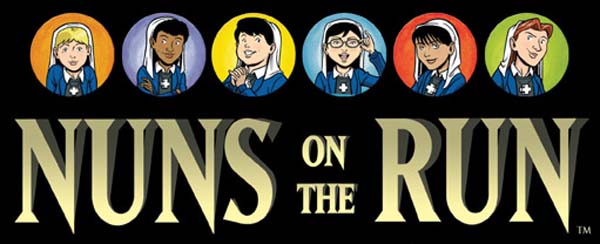
Here is a weird and somewhat unique game that pretty much everybody who I've played with has absolutely loved. More than once, I have had friends over, and we're looking for a not-too-long game to play to kill some time before other players show up for a bigger game. When this happens, after passing up games like Terraforming Mars or Bloodborne: the Card Game or Dominion (all of which are great games), I often just pull out Nuns On the Run and say, "OK, let's try this!". They're always skeptical of the choice, but I say "trust me", and by the time we finish a game, they all want to play again.
Nuns On the Run is a kind of an ideal game for a casual session. It's very quick and easy to set up. The basic rules are pretty easy to explain (even though the rulebook isn't great). It plays pretty quickly and smoothly, with most player action happening simultaneously. And it tears down quickly, making it a great "warm-up" game for a larger game, or as part of a marathon of light or medium-weight games.
Player movements are secret, so their tokens are not moved around the board unless detected by guards.
Secret sin
The theme of Nuns On the Run is that most players play as one of 6 different "novices" (young women in training to become a nun) in an abbey or convent. At night, each novice sneaks out of her bedroom to try to retrieve some secret wish and sneak back to her bedroom before dawn. However, another player (or 2) plays as a pair of adult nun guards, who patrol the convent and try to catch the novices and send them back to their rooms before they fall victim to their sinful desires. The secret desires range from relatively innocent things like a "letter from Mom", to a bottle of laudanum, to more exotic and malevolent things such as a "Book of Dark Magic" (which I always refer to as the Necronomicon).
The gimmick of the game is that all of the novices' moves are secret -- both to each other and to the player(s) playing as the guards. Instead of moving player tokens around the board, novices spend their turn writing their movement action and position on a sheet of paper. The guards, however, are on the board, and they follow pre-defined paths, which are public knowledge to all players. The game has line-of-sight rules, and also rules for novices making noise while they sneak around. If they are ever spotted by a guard, they put their token on the board in the location where they are seen. If they make a noise or disappear from a guard's vision, they place a "vanished" or "sound" token on the board at their last known position.
The secret movement means that all players take their turns simultaneously, so the game moves along swiftly, with hardly any downtime. After committing to their chosen movement, each player checks if their character would have crossed the line of sight of one of the guards, and then rolls a die to determine how much noise they make. The specific movement chosen modifies the die roll, and if the modified roll is less than or equal to the distance from the specific novice to a guard, then the guard hears the novice. Then the guards make their moves and roll a die to determine if they can hear any novices from the guards' new positions.
Secret wishes range from letters from loved ones, to sleeping medicine, to a book of black magic.
The first novice to claim her secret wish and return to her bedroom wins the game. If no novice accomplishes this goal before the end of the 15th turn, the sun comes up, and they are all caught out of bed after curfew, and the guards win. The guards also win if they catch the novices a specified number of times.
The guards are locked into their chosen patrol paths, unless they see or hear a novice in a given turn. However, they don't necessarily have to chase the novice who they spot or hear. Once alerted, the guards can move anywhere to chase or look for novices. Choosing which paths to follow, and where to look for novices when they see or spot something, makes up all of the strategy for the guards. It is best for an experienced player to play as the guards, since knowledge of the board, rules, and locations of keys and secret wishes makes a big difference in how the guards play.
[More]
eb54bfec-a691-4b6a-afb9-5a497e5da333|0|.0
Tags:Nuns on the Run, board game, Mayfair Games, Fréderic Moyersoen, Jared Blando, Jacob Chabot, Catholic, nun, convent, abbey, novice, stealth, blessing
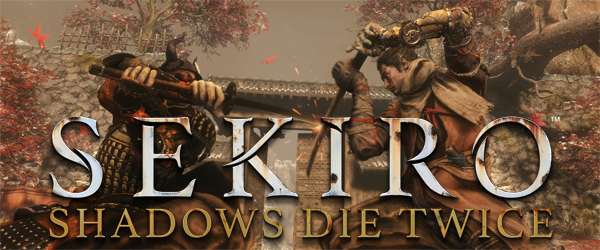
I never got into Tenchu because the
demos were too hard for younger me.
Oh, boy, was this a tough game to play and review! Frequent readers should probably know that I'm a huge Souls-Borne fan -- to the point of writing strategies and lore analyses. Sekiro is a bit different, however. It's much further divorced from Dark Souls than even Bloodborne was. Despite the lack of "Souls-Borne-ness" of Sekiro, I find it very difficult to put this review in any context other than of a new Souls-Borne release.
Sekiro is, ostensibly, a stealth game. There's more of Tenchu and Metal Gear in Sekiro than of Dark Souls. That's not necessarily a bad thing. I like stealth games just fine. The Metal Gear Solid games rank among one of my favorite game series ever.
I'm not terribly familiar with Tenchu, though. I think I played a demo of a PSX Tenchu game on one of my Official PlayStation Magazine demo discs (back in the day when publishers let players play pre-release demos, for free, instead of expecting us to pay for games long before they're even released, or holding the "open beta" hostage to a pre-order). I never bought the full Tenchu game because the demo was far too hard for my little 13 or 15-year-old gamer skills to handle. This was, of course, long before I started playing more demanding games.
Sekiro is in an awkward juxtaposition between Tenchu-inspired stealth, and Dark Souls-inspired boss fights.
However, there seems to be a certain degree of juxtaposition between Sekiro's desire to be a Tenchu-like stealth game, and its desire to feature demanding boss fights in-line with what is given in Souls-Borne games. In essence, we have two games here: a stealth game about staying out of sight of enemies and picking them off one-by-one; and a melee boss gauntlet in which the stealth isn't applicable at all. The first of those is good enough. The second one is where my problems begin...
My first playthrough of Demon's Souls was spent
cowering behind a shield.
All parry, all the time
You see, this really comes down to play-style. I was never a big parry-er in my Dark Souls-playing days. I parried a lot more in Bloodborne, but a big reason for that was that the guns allowed me to do so from a relatively safe distance. Heck, my first playthrough of Demon's Souls was done as the Royalty class, starting with the mana-regen ring, stabbing out with a winged spear from behind a shield, and using Soul Spear to dispatch any enemies I wasn't comfortable fighting up close. I hardly realized the parry mechanic existed!
Of course, I've grown and matured since 2008, and parrying has become a common element of my play-style. But I've still never been particularly good at it. This is causing me a lot of trouble in Sekiro because Sekiro's combat is all parrying, all the time! The new posture mechanic (which essentially replaces stamina) also means that a single parry isn't good enough to riposte and kill your enemy. You have to parry each strike in flurries of blows. For those coming from Dark Souls, imagine having to fight a hollow undead, and needing to parry every one of its wild slashes before you can riposte, instead of just the first one. That is what Sekiro expects and requires you to do.
Sekiro requires that you parry most attacks.
If you were a master-level parry-er in Dark Souls III, then you'll probably segue right into Sekiro with no problem and wonder what all the fuss is about. But for the rest of us plebs, that isn't going to be so easy.
This game plays much faster, enemies are much more aggressive, and health is in much smaller supply. Almost everything will kill you with two hits, and many grab attacks will drop you from full health to zero. This game leaves you with virtually no margin for error! Yet the mini-bosses and bosses have ridiculously high HP and posture.
... [More]
ecd29173-9c96-446a-944a-ddc20d5687ab|1|5.0
Tags:Sekiro, Sekiro: Shadows Die Twice, From Software, Activision, Hidetaka Miyazaki, Tenchu, Dark Souls, Demon's Souls, Bloodborne, stealth, boss, Japan, shinobi, samurai, mythology, lore, parry, deflect, deathblow, grinding
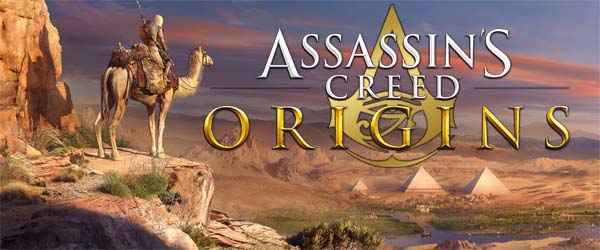
Hey, I actually managed to play and review all of this past holiday season's big, Triple-A releases! Hooray for me! I mean, sure it's the end of February, and I'm just now reviewing a game that came out last October, but at least I did play it.
Since the refreshing exceptionalism of Black Flag, the Assassin's Creed franchise has been scarred by mediocrity and controversy. As such, I opted to buy the game used off of eBay so as not to support Ubisoft. This is after I had enjoyed Black Flag so much that I happily bought a retail gift copy for a friend and recommended the game to yet another friend. Heck, if the save file could have been transferred over, I would have gladly traded in my PS3 copy of Black Flag for a PS4 retail copy.
Even Ubisoft realized that the series was growing stale, and stopped their cycle of releasing two or three games per year. It's been two full years since the last full release (Assassin's Creed: Syndicate in 2015). The extra time certainly helped elevate Assassin's Creed: Origins above the chaff of the rest of the franchise, but not quite enough to propel it to true greatness.
I played Origins on PS4, which means that I avoided the frustrations that many gamers reported involving Origins' multiple layers of DRM slowing down their computers. Wait, isn't Ubisoft the company that, years ago, publicly stated that DRM doesn't work, and that they "don't want to punish a paying player for what a pirate can easily work around"? This same company is now putting not one ... not two ... but three separate DRM applications on a single game? One of which is their own proprietary distribution service, U-Play? Is the company lying, or are they just scatterbrained and can't make up their mind? Or is the management just incompetent?
Would exploring tombs and temples by torchlight become a common mechanic?
Well, when I started up the actual game, I was pleasantly surprised that it starts off pretty damn strong. Even Black Flag was mired by an opening act that stranded players in a tedious, bog-standard Assassin's Creed
sandbox city for a couple hours before opening up the seas by giving us our own pirate ships. Origins, however, has a very strong, distinctive opening chapter that eventually gives way to a more bog-standard gameplay experience.
After an admittedly-silly and confusing opening cutscene that utterly fails to establish the setting or characters, Origins throws the player into a one-on-one duel to highlight the new combat mechanics, then hands main character Bayek a torch and asks the player to explore and escape from a derelict Egyptian temple. Then we head off across an intimidating swath of Saharan desert to the oasis that is Bayek's home town. Here, we have some open-ended exploration, hunting, rescue, and assassination missions. During this, we are introduced to the game's shining star: its setting and environment.
Classical Egypt is magnificently brought to life in this game. The map is vast and spread out, with large swaths of barren desert and sand dunes separating some of the game's regions. Small farming settlements and market hubs dot the environment, and each feels like a necessary part of a functional society. Best of all, Bayek isn't stopping every ten steps to pick up some random, meaningless collectible, and our map isn't cluttered with icons representing all this meaningless garbage.
Egypt feels vast, is beautiful, and is brimming with life and energy.
Not only does the map work well with its sense of physical scale, but it also excels at representing the temporal scale of Egypt. Even though we are playing in antiquity, the game world is still dotted with tombs and abandoned settlements, some of which are thousands of years old. Remember, ancient Egypt is one of the longest-lasting civilizations in the history of the world, having been a world superpower for over three thousand years! The time span between the building of the Great Pyramids in Giza, and the life of Cleopatra is longer than the time span between Cleopatra and our lives today. Assassin's Creed: Origins completely nails that sense of living in this ancient kingdom... [More]
127c637d-fe49-4052-bc0a-c76d2f790de8|0|.0
Tags:Assassin's Creed, Assassin's Creed: Origins, Ubisoft, history, RPG, action, combat, stealth, parkour, Egypt, Rome, Bayek, Cleopatra, McGuffin, Dark Souls, micro-transaction, eBay
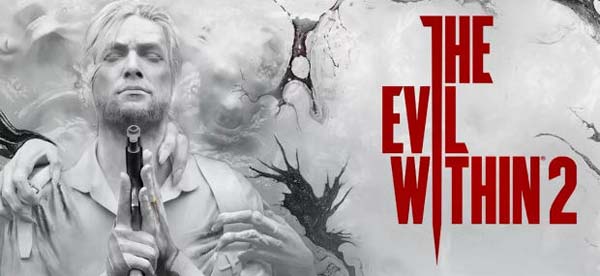
Okay, I said I would give up on Shinji Mikami after the first Evil Within game, but here I am giving that IP a second chance. I had heard that the expansions for Evil Within were actually pretty good, and that they even made the base game better by filling in some of the narrative gaps. But I was so furious with the base game that I sure as hell was not going to shell out more money for DLCs. If they were that integral to the core game, then they should have been included with the core game. Now that my furor over the original has faded a bit, I was hearing that the sequel is also much better than the original game and leans more heavily in the horror camp than the action shooter camp. I was dismissive of the game's announcement, and I was skeptical of the claims that the sequel was actually good, so I picked up a [relatively] cheap used copy off eBay so that I could give it a chance over the Halloween week without necessarily giving any more money to Bethesda.
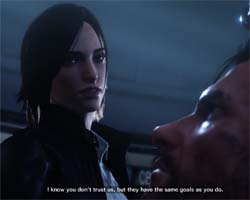
I feel like I missed something...
Maybe I should've played the DLC?
Besides, Shinji Mikami isn't the director this time around. Instead the sequel is directed by John Johanas, who was the director of the [supposedly] good DLC expansion packs. The first game actually did have some good ideas and set pieces within, so maybe a different directorial approach could bring those ideas out to their full potential?
A more focused package
To Johanas' credit, the game, as a whole, definitely has a more "unified" presentation. The first game felt very scattershot with regard to how it wanted the player to play. It's early chapters (which were also the most enjoyable parts of the game) were focused mostly on stealth, with a few pursuit and escape moments thrown in. It was slow, somewhat atmospheric, and built incredible tension. But those mechanics were quickly dropped in favor of shooting gallery set pieces, constant scripted ambushes, set piece boss encounters, and frantic, funhouse-ish trap / puzzle rooms. The sequel, thankfully, is much more focused. I didn't feel like I was wasting my resources by putting points into Sebastian's stealth skills (a skill tree that was completely absent from the previous game), as you can actually continue to use them over the course of the entire game. Sure, there's still scripted ambushes and puzzle rooms, but the focus is much more firmly planted in sneaking around, exploring the environments, and generally avoiding detection.
Unfortunately, there's still a bit too much of a focus on frenzied action. It detracts significantly from any sort of horror or tension that the game might be trying to build up. The autosaves are fairly generous (even though there are also manual save points in each of the game's safe houses), so enemies come in hordes, hit very hard, and deaths are going to happen. Chapter 3 basically completely desensitized me to death and put me in the habit of just standing up and letting the monsters kill me if I ever screwed up the stealth.
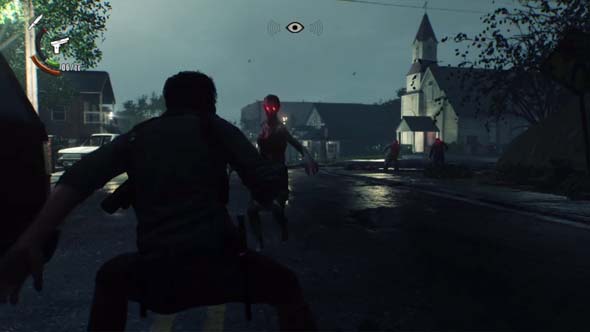
The early combat encounters are not gentle, as they put you up against hordes of enemies.
There's a greater focus on open-ended exploration this time around, and Chapter 3 is the first open map that the player is free to explore. There's basically two main paths through it: the hard one and the easy one. The easy path is basically a straight line due north from where you start, but the game throws some curveball objectives at you that basically encourage you to try the other paths that end up being much harder. You're told about weapon caches and NPCs that you're supposed to try to save. One such weapon is the crossbow, which is actually a pretty necessary tool (because, you know, every game has to have a crossbow). It's right off to the side of where you start, but picking it up can easily lead you down a much harder path to your actual mission objective... [More]
a80e28ec-25a4-48ed-8bdc-50264cab70ac|1|4.0
Tags:The Evil Within, The Evil Within 2, Bethesda, Tango Gameworks, survival horror, horror, action, shooter, open world, sandbox, stealth, zombies, mental institution, virtual reality, psychopath, Sebastian Castellanos, eBay, John Johanas, Shinji Mikami, Resident Evil, Silent Hill
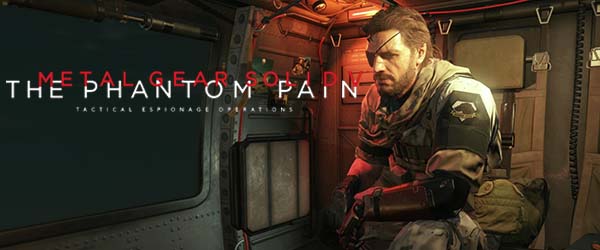
Are you one of the poor suckers who paid $30-40 for Ground Zeroes and were ready for The Phantom Pain to make up for your disappointment with what was little more than a glorified (and over-priced) demo? I wasn't, because I got Ground Zeroes for free from my PSPlus subscription around the same time that Phantom Pain was released. I was obviously disappointed with the demo's short length, and I didn't bother doing any of the side missions. But since I didn't pay for it, I wasn't as enraged as some other players might have been.
I actually really liked what little gameplay Ground Zeroes had to offer. The Guantanamo Bay arena was well-designed and offered some good infiltration challenge that tested my Metal Gear capabilities. The A.I. was surprisingly competent and adaptive - not so much that I couldn't exploit them occasionally, but still good. The graphics, lighting, and weather effects all looked outstanding. It was a fun experience. Not "forty dollars fun", but pretty fun. At least part of the battle at Mother Base should have been playable, and I didn't like that large elements of the story were hidden away in collectible audio tapes, but whatever.
I got Ground Zeroes for free on PSPlus, instead of paying $30-40 MSRP for a glorified demo.
Ground Zeroes gave me flashbacks to the phenomenal classic Sons of Liberty demo that came packaged with Zone of the Enders on the PS2. At least that only cost me a $3 rental, and I got to play Zone of the Enders too. After Ground Zeroes, I was looking forward to getting my hands on the much bigger Phantom Pain, and was optimistic that it would provide an equally good experience that would be worth the purchase price. Phantom Pain is a very long, very complicated, and very uneven game. So buckle up, friend. This is going to be a long review.
Table of Contents
After having written a lengthy blog post about how open world, sandbox game design almost necessarily puts the game's narrative in a state of limbo, I was amazed to start up Metal Gear Solid V and see the very first mission took my criticisms to heart. Of course, the game had already been released by the time I had written that opinion piece, so I can't take credit for having influenced its development, but it was still refreshing and gratifying. Anyway, in the very first mission, Ocelot tells you that Miller has been captured by Soviets in Afghanistan, has been tortured for intel, and has three days - tops - to live. You must rescue him before that time.
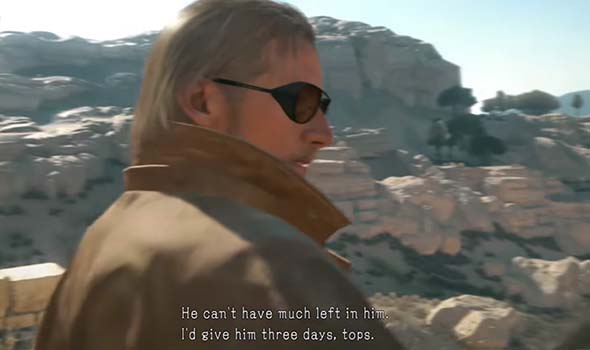
Ocelot gives the player three days to rescue Miller...
At first, I didn't put much stock in Ocelot's claim. After all, sandbox games are notorious for saying that something needs to be done ASAP, but they never have the balls to actually walk the walk and enforce that objective. Until now. When checking my map, I noticed something in the corner that I hadn't noticed in other sandbox games before: an "elapsed time" counter. The game was plainly tracking how long it was taking me to complete the primary mission objective. I treated this timer with a certain degree of skepticism. But sure enough, failure to rescue Miller within the allotted time actually results in a "Game Over"!
This is exactly how I feel that priority objectives in open world games should be handled: make it apparent to the player (through dialogue and/or explicit notification) that an objective is being timed or that it is otherwise a priority, and make sure that there are reasonable, perceivable consequences for failure to achieve that objective within the expected conditions. Then design some early-game quests or objectives such that the player is put in a position in which they can (or must) fail; thus, teaching the player that when the game says "do x or else", the game actually means it. I put down the controller and gave Hideo Kojima a standing ovation. But would this opening mission set a precedent that priority missions must actually be prioritized, and would that precedent stand throughout the rest of the game? Or was this just a one-off occurrence that would not be representative of the rest of the game? Regardless, a tone was plainly set for the rest of the game, and the stakes had been raised.
... Failure to rescue Miller within the allotted time results in his death and a Game Over.
Would this refreshing precedent carry over into the rest of the game? Well, sort of... [More]
11c3f412-b61e-422f-96c9-742ddb50d6fb|5|4.2
Tags:Metal Gear, Metal Gear Solid, Metal Gear Solid V: the Phantom Pain, Konami, Hideo Kojima, Fox Engine, tactical espionage operations, tactical espionage action, espionage, stealth, snake, Big Boss, Revolver Ocelot, Quiet, dog, Diamond Dogs, Afghanistan, Africa, open world, desert, sandbox, Fulton Recovery System, balloon, horse, Mother Base, helicopter, Soviet Union, Skull Face, Cipher, Zero, Sahelanthropus, Keifer Sutherland, David Hayter, ludonarrative, ludonarrative harmony, FOB, online, PvP, Metal Gear Online
|

| 12 | | | | | | | 60 | | 11 | | | | | | | 55 | | 10 | | | | | | | 50 | | 09 | | | | | | | 45 | | 08 | | | | | | | 40 | | 07 | | | | | | | 35 | | 06 | | | | | | | 30 | | 05 | | | | | | | 25 | | 04 | | | | | | | 20 | | 03 | | | | | | | 15 | | 02 | | | | | | | 10 | | 01 | | | | | | | 05 |
|